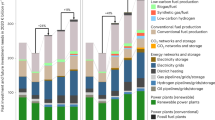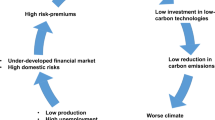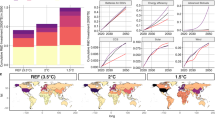Abstract
Low-carbon, 'green' economic growth is necessary to simultaneously improve human welfare and avoid the worst impacts of climate change and environmental degradation. Infrastructure choices underpin both the growth and the carbon intensity of the economy. This Perspective explores the barriers to investing in low-carbon infrastructure and some of the policy levers available to overcome them. The barriers to decarbonizing infrastructure 'nest' within a set of barriers to infrastructure development more generally that cause spending on infrastructure—low-carbon or not—to fall more than 70% short of optimal levels. Developing countries face additional barriers such as currency and political risks that increase the investment gap. Low-carbon alternatives face further barriers, such as commercialization risk and financial and public institutions designed for different investment needs. While the broader barriers to infrastructure investment are discussed in other streams of literature, they are often disregarded in literature on renewable energy diffusion or climate finance, which tends to focus narrowly on the project costs of low- versus high-carbon options. We discuss how to overcome the barriers specific to low-carbon infrastructure within the context of the broader infrastructure gap.
This is a preview of subscription content, access via your institution
Access options
Subscribe to this journal
Receive 12 print issues and online access
$209.00 per year
only $17.42 per issue
Buy this article
- Purchase on Springer Link
- Instant access to full article PDF
Prices may be subject to local taxes which are calculated during checkout




Similar content being viewed by others
References
Kennedy, C., Ibrahim, N. & Hoornweg, D. Low-carbon infrastructure strategies for cities. Nat. Clim. Change 4, 343–346 (2014).
Clark, W. & Cooke, G. Smart Green Cities: Toward a Carbon Neutral World (Routledge, 2016).
Pathways to a Low-Carbon Economy: Version 2 of the Global Greenhouse Gas Abatement Cost Curve (McKinsey & Company, 2009).
Pye, S., Watkiss, P., Savage, M. & Blyth, M. The Economics of Low Carbon, Climate Resilient Patterns of Growth in Developing Countries: A Review of the Evidence (Stockholm Environment Institute, 2010).
Renewable Power Generation Costs in 2014: International Renewable Energy Agency (IRENA, 2015).
Metz, B. in Climate Finance: Regulatory and Funding Strategies for Climate Change and Global Development (eds Stewart, R., Kingsbury, B. & Rudyk, B.) Ch. 3, 42–47 (New York Univ. Press, 2009).
Emerging Trends in Mainstreaming Climate Resilience in Large Scale, Multi-Sector Infrastructure PPPs (World Bank, 2016).
Is it Time for an Infrastructure Push? The Macroeconomic Effects of Public Investment (International Monetary Fund, 2014).
Better Growth, Better Climate (The New Climate Economy Report: Global Commission on the Economy and Climate, 2014).
The Cost of Inaction: Recognizing the Value at Risk from Climate Change (The Economist Intelligence Unit, 2015); http://go.nature.com/2edVdH5
Stern, N. The Stern Review on the Economics of Climate Change (Cambridge Univ. Press, 2007).
Adoption of the Paris Agreement (United Nations Framework Convention on Climate Change, 2015).
Bhattacharya, A., Romani, M. & Stern, N. Infrastructure for Development: Meeting the Challenge (Grantham Research Institute on Climate Change and the Environment, 2012).
Drew, E. A Country Breaking Down The New York Review of Books (25 February 2016).
Making Public Investment More Efficient (International Monetary Fund, 2015).
Gutman, J., Sy, A. & Chattopadhyay, S. Financing African Infrastructure: Can the World Deliver? (Brookings, 2015).
Bhattacharya, A., Oppenheim, N. & Stern, N. Driving Sustainable Development Through Better Infrastructure: Key Elements of a Transformation Program (Brookings, The New Climate Economy, and Grantham Research Institute on Climate Change and the Environment, 2015).
Mobilizing Public and Private Funds for Inclusive Green Growth Investment in Developing Countries (International Finance Corporation, 2013).
Foster, V. & Briceno-Garmendia, C. Africa's Infrastructure: A Time for Transformation (World Bank, 2010).
Towards a Framework for the Governance of Infrastructure (OECD, 2015).
Gennaioli, C. &, Tavoni, M. Clean or dirty energy: evidence of corruption in the renewable energy sector Public Choice 166, 261–290 (2016).
Tanzi, V. & Davoodi, I. Corruption, Public Investment, and Growth (International Monetary Fund, 1997).
Gilbert, P. Partnerships Help Bridge the Infrastructure Gap (Boston Consulting Group, 2013).
Verdoux, W., Uzsoki, D. & Ordonez, C. Currency Risk in Project Finance (International Institute of Sustainable Development, 2015).
Wells, J. & Hawkins, J. Increasing 'local content' in infrastructure procurement. Part 1 Proc. Inst. Civil Engineers Management Procurement Law 163, 65–70 (2010).
India: Diagnostic Assessment of Select Environmental Challenges (World Bank, 2013).
India: Green Growth is Necessary and Affordable for India, Says New World Bank Report World Bank (17 July 2013).
World Energy Outlook 2014 (International Energy Agency, 2014).
How Large are Global Energy Subsidies? (International Monetary Fund, 2015).
Cervigni, R., Liden, R., Neuman, J. E. & Strzepek, K. M. (eds) Enhancing the Climate Resilience of Africa's Infrastructure: The Power and Water Sectors Conference Edition (World Bank, 2015).
Unruh, G. Understanding carbon lock-in Energy Pol. 28, 817–830 (2000).
Liu, L. & Waibel, M. in Macro Federalism and Local Finance (ed. Shah, A.) Ch. 6 (World Bank, 2008).
Mbeng Mezui. C. & Hundal, B. Structured Finance: Conditions for Infrastructure Project Bonds in African Markets (African Development Bank Group, 2013).
Micale, V., Trabacchi, C. & Boni, L. Using Public Finance to Attract Private Investment in Geothermal: Olkaria III Case Study (Climate Policy Initiative, 2015).
Hogarth, J. The role of climate finance in innovation systems J. Sustain. Financ. Investment 2, 257–274 (2012).
Colverson, S. & Perera, O. Harnessing the Power of Public-Private Partnerships: The role of hybrid financing strategies in sustainable development (International Institute for Sustainable Development, 2012).
Sarmenot, J. Do public-private partnerships create value for money for the public sector? The Portuguese experience OECD J. Budgeting http://doi.org/fwzhnr (2010).
Whitley, S. & Granoff, I. The Moroccan Agency for Solar Energy and the Moroccan Solar Plan (Green Growth Best Practice, 2014).
Annual Survey of Large Pension Funds and Public Pension Reserve Funds: Report on Pension Funds' Long-Term Investments (OECD, 2014).
Kaminker, C. & Stewart, F. The Role of Institutional Investors in Financing Clean Energy (OECD, 2012).
Baily, B. An institutional truth: increasing institutional investor involvement in climate finance Georgetown Int. Environ. Law Rev. 27, 447–477 (2015).
History: Explosive Growth in Green Bonds Market (Climate Bonds Initiative, 2014); https://www.climatebonds.net/market/history
Green Bonds Attract Private Sector Climate Finance (World Bank, 2015).
Berger, L. What you need to know about how clean energy yieldcos work. Greentech Media (10 July 2014).
Roselund, C. Solar goes public: the rise of yieldcos. PV Magazine (August 2014).
Croce, R. & Gatti, S. Financing infrastructure — international trends OECD J. Financ. Mark. Trends 2014, 123–138 (2014).
Zuckerman, J., Frejova, J., Granoff, I. & Nelson, D. Investing at Least a Trillion Dollars a Year in Clean Energy Working paper (New Climate Economy, 2015).
Mandel, J. Solar Securitization. RMI Outlet (15 January 2014).
State and Trends in Carbon Pricing 2015 (World Bank, 2015).
Bast, E., Doukas, A., van der Burg, L. & Whitley, S. Empty Promises: G20 Subsidies to Oil, Gas and Coal Production (Overseas Development Institute, 2015).
Jakob, M., Chen, C., Fuss, S., Marxen, A. & Edenhofer, O. Development incentives for fossil fuel subsidy reform Nat. Clim. Change 5, 709–711 (2015).
Pogue, M. A Discounted Rate? The Impact of Discount Rates on Infrastructure (Univ. Toronto, 2015).
Buchner, B., Trabacchi, C., Mazza, F., Abramskiehn, D. & Wang, D. Global Landscape of Climate Finance 2015 (Climate Policy Initiative, 2015).
Climate Risk Management in ADB Projects (Asian Development Bank, 2014).
World Bank Policies Include Screening for Climate Risks (World Bank, 2014).
Failing to Solve Energy Poverty: How Much International Public Investment is Going to Distributed Clean Energy Access (Sierra Club and Oil Change International, 2014).
Scott, A. & Wykes, S. UK Support for Energy in developing countries (CAFOD; 2015).
Rydge, J., Jacobs, M. & Granoff, I. Ensuring New Infrastructure is Climate-Smart Working paper (Global Commission on Economy and Climate Change, 2015).
Morris, S. & Gleave, M. The World Bank at 75 Policy Paper 58 (Center for Global Development, 2015).
Global Infrastructure Facility (World Bank, 2015); http://www.worldbank.org/en/programs/global-Infrastructure-facility
Acknowledgements
An earlier draft of this paper was written by the authors for an internal strategy meeting of the Global Green Growth Institute (GGGI). We would like to acknowledge GGGI's support for the project, as well as the support provided by our colleagues at the Overseas Development Institute.
Author information
Authors and Affiliations
Contributions
I.G. conceived the project in consultation with GGGI. I.G., J.R.H. and A.M. jointly conducted the analysis and wrote the paper.
Corresponding authors
Ethics declarations
Competing interests
The authors declare no competing financial interests.
Supplementary information
Supplementary Information
Supplementary Information (PDF 156 kb)
Rights and permissions
About this article
Cite this article
Granoff, I., Hogarth, J. & Miller, A. Nested barriers to low-carbon infrastructure investment. Nature Clim Change 6, 1065–1071 (2016). https://doi.org/10.1038/nclimate3142
Received:
Accepted:
Published:
Issue Date:
DOI: https://doi.org/10.1038/nclimate3142
This article is cited by
-
Meta-analysis on necessary investment shifts to reach net zero pathways in Europe
Nature Climate Change (2023)
-
Do financial development, financial stability and renewable energy disturb carbon emissions? Evidence from asia–pacific economic cooperation economics
Environmental Science and Pollution Research (2023)
-
Accounting for finance in electrification models for sub-Saharan Africa
Nature Energy (2022)
-
Africa needs context-relevant evidence to shape its clean energy future
Nature Energy (2022)
-
Misplaced expectations from climate disclosure initiatives
Nature Climate Change (2021)



